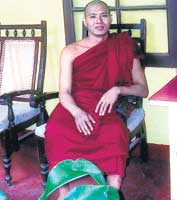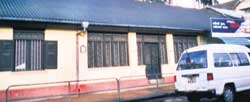
| Where the Burmese came to rest On D.S. Senanayake Veediya, earlier known as Trincomalee Street, close to Trinity College, stands a low- roofed building - the Burmese Temple. Once you enter the premises, there is a quiet, serene and cool atmosphere and you do not realize that you are in the middle of the city. Though the board on the wall states 'Burmese Rest', Ven. Acinna Thera (pronounced Achena), the present incumbent of the Burmese Temple says it was always a temple or viharaya. It was, however, a place of rest for Burmese Theras and pilgrims from Burma and the West who visited Kandy. "In 1985 there were 250 doctors who came on a WHO programme to Sri Lanka and worked in various parts in the country. During their holidays they stayed at the Burmese temples in Kandy and Colombo," says the Ven. Acinna Thera.
The High Priest who established the monastery was Ven.Vinayalankara Thera. "There are five Burmese temples in Sri Lanka," states Ven. Acinna Thera. One is at Pokunuwita about 25 miles from Colombo on the Avissawella road which is 100 years old. The second viharaya named Sri Vinayalankara is at Maradana in Colombo. The other is near the Sri Mahabodhi in Anuradhapura and there is another in Dematagoda named Makutarama Viharaya and in Kandy, the Sri Vinayalankara Viharaya. Ven. Vinayalankara was well versed in Sinhala. He conducted Dhamma talks and many other Buddhist programmes in Sinhala and there were many laymen who came to visit this temple. This Thera had four disciples, two Burmese and two Sinhalese. Ven. Chandawimala was in Pokunuwita, Ven. Siggava was given the Anuradhapura Vihara and the Makutarama in Dematagoda with another Thera in residence. Ven. Gnanalankara Thera, the second High Priest was in Kandy. Before he passed away, he handed it over to Ven.Sumanasagara Thera. "This Thera lived in Sri Lanka for 45 years and returned to Myanmar. He is now 85 and visited Sri Lanka recently and stayed in Kandy for a month," Ven. Acinna Thera says. At present, three Burmese priests Ven. Acinna, Ven. Manijothi and Ven. Vilasa Theras live in this temple. On Poya days devotees come to the temple to offer flowers and meditate. On October 15, we had the 'Katina Pinkama' after the 'Vas season', said Ven. Acinna Thera.
However, the Thera states that the rituals and customs are somewhat different in Myanmar. "Burma (Myanmar) is a Theravada Buddhist country where 85 percent of the people are Buddhists," he explains. "In Myanmar, parents think it a great honour to ordain their sons. I have four brothers and my parents wanted to see me in robes. I was initiated as a 'samanera' (student monk) three times. First when I was 7 years, but I returned home. Next, when I was 10 years and again I left the temple and finally when I was 12 years old," he says. "It is very expensive to become a monk and my parents had to spend a lot of money for my initiation and higher ordination," he recalls. They have to invite all the people in the village as well as people from neighbouring villages and provide food for all of them for two days.” The Thera remembers that his parents were very happy and there were tears of joy in their eyes on the day of his higher ordination. "The ordinations are mainly in summer, in April and May," he says. Ven. Acinna Thera states that there are about 400,000 monks and 50,000 nuns in Myanmar. People are very religious and they give alms on their birthdays, weddings and other important events in their lives. In Upper Myanmar, there are about 1000 monks in each temple and in Lower Myanmar about 300, says the Thera. After 10 years of learning and a higher Pali Degree, Ven. Acinna Thera trained in meditation for one year. He had to meditate for 18 hours every day for 45 days. Getting up at 3 a.m., until 4 a.m., it was walking meditation. After this came the sitting form of meditation until 6 a.m. From 9 - 8, it was sitting and walking or listening to talks by the High Priest. "During my time there were 6000 meditators, monks and laymen." The Thera states that there are two methods of meditation - one is the Mahasi method, where the rising and falling movements of the abdomen are concentrated on and the other is the Ananapanasati meditation of breathing in and out consciously. "In 1996, at the age of 19, I came to study English at the Aquinas College in Colombo," stated Ven Acinna Thera. During 1997/98, he studied at the Buddhist and Pali University to obtain his MA . Thereafter, in 2001 he travelled widely in Canada, U.S.A. and Japan to teach meditation with Ven. Indaka Thera, the Burmese high priest. "I translated the Burmese language to English when he taught meditation. There were many people in the West who wanted to learn meditation and were interested in Buddhism,” he recalls. In 2002, he returned to Sri Lanka. When I visited the Burmese temple, the Thera was busy helping with the renovation of the old building. He too was working with the masons mixing cement and sand and instructing them on how the work should be done. |
| || Front
Page | News
| Editorial
| Columns
| Sports
| Plus
| Financial
Times | International
| Mirror
| TV
Times | Funday
Times | Kandy
Times || |
| |
Copyright
2006 Wijeya
Newspapers Ltd.Colombo. Sri Lanka. |

